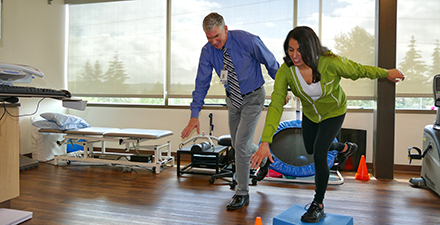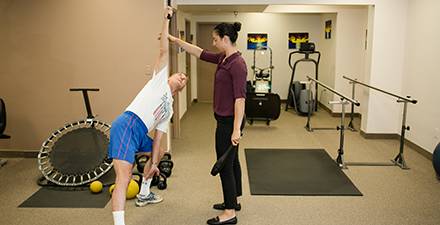To support the physical therapy profession in the future, it's important to understand what the physical therapy landscape looks like now. That's why APTA is committed to using workforce planning to optimize the patient experience and consumer access to physical therapy.
Two new reports, "A Physical Therapy Profile: Wages Earned in the Profession, 2021-22" and "A Physical Therapy Profile: Demographics of the Profession, 2021-22," offer insights into changes in demand, employment potential, comparisons among regions and specialties, and more.
APTA has collected data on the wages of member PTs and PTAs at varying intervals between 2004 and 2021 as part of its recurring practice profile surveys, and now reports findings based on its analysis of the survey responses. For the report on demographics, the association compared membership data with information from the Bureau of Labor Statistics and the U.S. Census Bureau, as well as from the Federation of State Boards of Physical Therapy, the Commission on Accreditation in Physical Therapy Education, and APTA’s centralized application systems for PT and PTA students.
One key finding: APTA membership largely reflects the profession as a whole in terms of practice setting, female-to-male ratio, and age — reinforcing the value of APTA member surveys.
Here are a few of the highlights.
Physical therapy professionals are a growing part of the health care workforce. There are about 72 PTs for every 100,000 people nationwide, which is up from 65 per 100,000 in 2017. With a reported 225,330 physical therapists according to 2021 U.S. Bureau of Labor Statistics data, "physical therapist" is the fifth largest clinical occupation in the health care field that requires state licensure or certification, excluding general nursing.
Income has not kept pace with inflation in most areas. Median annual wages range from $88,000 to $101,500 for PTs and from $50,000 to $60,000 to PTAs. PT and PTA annual wages matched or exceeded cost-of-living increases between 2004 and 2013, but wages either met or fell behind the rate of inflation between 2016 and 2021, in all regions except the West North Central region for PTs and New England regions for PTAs.
Community type does not significantly influence wages, but practice setting and clinical focus can. PTs and PTAs working in metropolitan areas don't make significantly more or less than their peers who work in small towns or rural areas. Among practice settings, however, wages vary. Among PTs, school-based clinicians earn the lowest wage both annually and hourly, while PTs in skilled nursing earn the highest annual wage and PTs in acute care settings earn the highest hourly wage. PTAs in private outpatient offices earn the least annually, and those in school systems earn the least by the hour; highest annual wages are in higher education, and highest hourly wages are in home care. An important note: Nearly two-thirds of PTAs work on an hourly basis rather than receive an annual salary.
Turning to clinical focus, clinical electrophysiologic PTs earn the highest hourly wage, an average $33.63 more than PTs working with lymphedema, which is the lowest-paid clinical focus area on an hourly basis. (Clinical electrophysiology is a bit of an outlier in that only PTs board certified in that specialty are able to practice in the field. The next highest hourly wages are in neurology at $6.15 above lymphedema.) Among PTAs, those working in geriatrics earn the highest hourly wage, an average $5.89 more than those working in pediatrics, the lowest-paid clinical focus area.
Clinical specialization and residency training matter, too. Board-certified clinical specialists earn an estimated $4,540 more per year on average across specialty areas compared with their peers who are not board certified. Hourly wages within each of those groups varied: Among board-certified specialists, PTs who are board certified in clinical electrophysiologic physical therapy — the only PTs eligible to bill for these specific, high-paying CPT codes — earn an average $27.20 an hour more than women's health physical therapy clinical specialists, the lowest-paid specialty. Completing a residency also can boost PT wages, especially for those early in their careers: PTs who complete residency training have higher first-time pass rates (94%) on the clinical specialization exam compared with their peers who do not complete a residency (77%). With higher first-time certification rates and an earlier start to clinical specialization, residencies can allow PTs to start enjoying the increased earnings associated with specialization earlier in their careers.
Experience makes a difference when it comes to wages. PTs earn an average $800 more a year, and PTAs earn an average $220 more a year, for each year of experience in the field of physical therapy. From starting salary to 16-plus years of experience, average wages for PTs increase from $72,000 to $104,000. For PTAs, the average salary starts at $49,000 and increases to $69,000 for 31-plus years of experience.
The distribution of PTs and PTAs across the country is uneven. The states with the highest concentrations of physical therapists per 100,000 people are in New England and Hawaii; Nevada, Alabama, Arizona, and New Mexico have the lowest concentrations of physical therapists. (Check out the maps on Pages 6 and 8 of the demographics report to see how your state compares with others.)
Women hold most PT and PTA jobs, and the gender wage gap not universal. APTA, BLS, and Census Bureau estimates show that about two-thirds of PTs and PTAs are women. This ratio is consistent among board-certified clinical specialists, but men are seeking PT fellowships at a higher rate than women. When looking at 2021 data from the Bureau of Labor Statistics, female PTs earn $0.95 for every $1 earned by male PTs. However, further analysis reveals a nuanced picture. Knowing that years of experience strongly influence wages, APTA broke down member survey data by years of experience. This analysis revealed that there was only a wage gap between female and male PTs among those with 11-15 years of experience and those with 31-35 years of experience. There weren't any statistically significant gaps at any other experience levels. Additionally, the overall gap in median wages between female and male PTs began to narrow in 2016, becoming half as wide in 2021 as in 2013.
Ethnic and racial diversity in the profession is increasing. In general, the racial and ethnic diversity of APTA membership and of the U.S. physical therapy workforce does not match the population that PTs and PTAs serve. The percentage of white and Native Hawaiian or Other Pacific Islander PTs and PTAs largely matches the population representation, as does the percentage of Asian PTAs. Black/African American and Hispanic/Latino PTs and PTAs are underrepresented, and Asian PTs are overrepresented. However, data from CAPTE and the APTA Physical Therapist Centralized Application Services show that the number of students from underrepresented minority communities accepted into DPT programs increased from 28% in 2017 to 32% in 2021.

